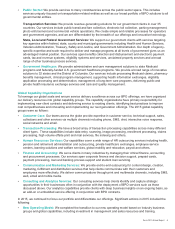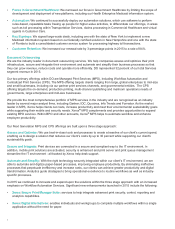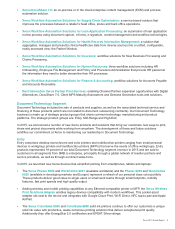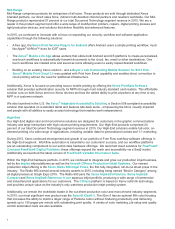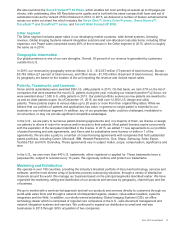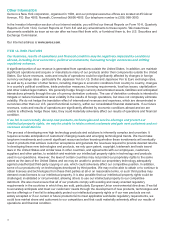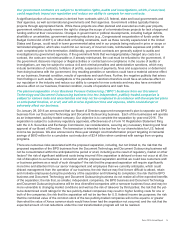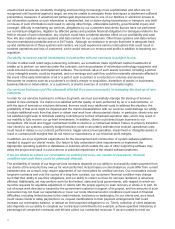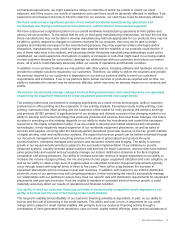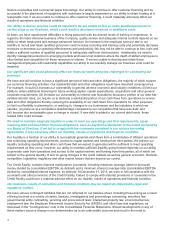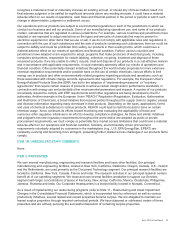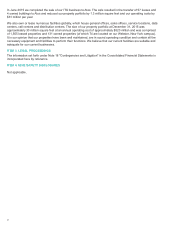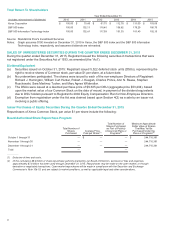Xerox 2015 Annual Report Download - page 31
Download and view the complete annual report
Please find page 31 of the 2015 Xerox annual report below. You can navigate through the pages in the report by either clicking on the pages listed below, or by using the keyword search tool below to find specific information within the annual report.Our government contracts are subject to termination rights, audits and investigations, which, if exercised,
could negatively impact our reputation and reduce our ability to compete for new contracts.
A significant portion of our revenues is derived from contracts with U.S. federal, state and local governments and
their agencies, as well as international governments and their agencies. Government entities typically finance
projects through appropriated funds. While these projects are often planned and executed as multi-year projects,
government entities usually reserve the right to change the scope of or terminate these projects for lack of approved
funding and/or at their convenience. Changes in government or political developments, including budget deficits,
shortfalls or uncertainties, government spending reductions (e.g., Congressional sequestration of funds under the
Budget Control Act of 2011) or other debt or funding constraints, such as those recently experienced in the United
States and Europe, could result in lower governmental sales and in our projects being reduced in price or scope or
terminated altogether, which also could limit our recovery of incurred costs, reimbursable expenses and profits on
work completed prior to the termination. Additionally, government contracts are generally subject to audits and
investigations by government agencies. If the government finds that we inappropriately charged any costs to a
contract, the costs are not reimbursable or, if already reimbursed, the cost must be refunded to the government. If
the government discovers improper or illegal activities or contractual non-compliance in the course of audits or
investigations, we may be subject to various civil and criminal penalties and administrative sanctions, which may
include termination of contracts, forfeiture of profits, suspension of payments, fines and suspensions or debarment
from doing business with the government. Any resulting penalties or sanctions could have a material adverse effect
on our business, financial condition, results of operations and cash flows. Further, the negative publicity that arises
from findings in such audits, investigations or the penalties or sanctions therefore could have an adverse effect on
our reputation in the industry and reduce our ability to compete for new contracts and may also have a material
adverse effect on our business, financial condition, results of operations and cash flow.
The planned separation of our Business Process Outsourcing (“BPO”) business from our Document
Technology and Document Outsourcing business into two independent, publicly-traded companies is
subject to various risks and uncertainties and may not be completed in accordance with the expected plans
or anticipated timeline, or at all, and will involve significant time and expense, which could disrupt or
adversely affect our business.
On January 29, 2016 we announced that our Board of Directors approved management’s plan to separate our BPO
business from our Document Technology and Document Outsourcing business. Each of the businesses will operate
as an independent, publicly-traded company. Our objective is to complete the separation by year-end 2016. The
separation is subject to customary regulatory approvals, effectiveness of a Form 10 Registration Statement filing
with the U.S. Securities and Exchange Commission, tax considerations, securing any necessary financing and final
approval of our Board of Directors. The transaction is intended to be tax-free for our shareholders for U.S. federal
income tax purposes. We also announced a three-year strategic cost transformation project targeting incremental
savings of $600 million for a cumulative cost reduction of $2.4 billion when combined with savings from on-going
programs.
There are numerous risks associated with the proposed separation, including, but not limited to, the risk that the
proposed separation of the BPO business from the Document Technology and Document Outsourcing business will
not be consummated within the anticipated time period or at all, including as the result of regulatory, market or other
factors? the risk of significant additional costs being incurred if the separation is delayed or does not occur at all; the
risk of disruption to our business in connection with the proposed separation and that we could lose customers and/
or business partners as a result of such disruption? the risk that the proposed separation will require significantly
more time and attention from our senior management and employees than we currently anticipate, which could
distract management from the operation of our business; the risk that we may find it more difficult to attract, retain
and motivate employees during the pendency of the separation and following its completion; the risk that the BPO
business and Document Technology and Document Outsourcing business do not realize all of the expected benefits
of the separation; the risk that, as smaller, independent companies, the BPO business and Document Technology
and Document Outsourcing business will be less diversified companies with a narrower business focus and may be
more vulnerable to changing market conditions and well as the risk of takeover by third parties; the risk that the yet-
to-be determined credit ratings for the two publicly-traded companies may result in higher funding costs for one or
both of the companies; the risk that the separation will not be tax-free for U.S. federal income tax purposes; the risk
that the combined value of the common stock of the two publicly-traded companies will not be equal to or greater
than what the value of Xerox common stock would have been had the separation not occurred; and the risk that the
expected amount of cost reductions under the cost transformation program will not be realized.
Xerox 2015 Annual Report 14




